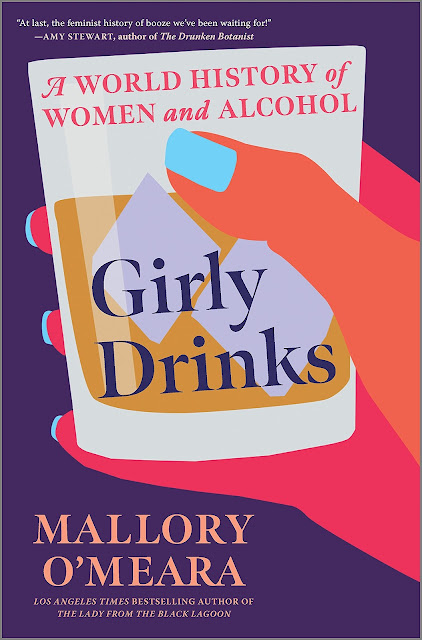Best Of Girly Drinks by Mallory O'Meara
Here is a selection of memorable quotes from Girly Drinks: A World History of Women and Alcohol by Mallory O'Meara
The foundations of alcohol craft and culture were laid by female hands. The first known depiction of drinking was of a woman, and the first alcohol-related deity was a goddess. Thousands of years before Christians drank the wine of the Eucharist, thousands of years before Dionysus was worshipped with wine in Greece, Ninkasi was honoured with beer by the Sumerian women who brewed and drank it. Her dominion over all aspects of alcohol is a symbol of how influential women have been.
p.27
But we do know that women in ancient Egypt liked to drink, and they also liked to get men drunk. Drinking and sexuality were closely linked. there was an affluent Egyptian woman named Chratiankh (birth and death dates unknown) whose tomb inscription read I was a mistress of drunkenness, one who loved a good day, who looked forward to [having sex] every day, anointed with myrrh and perfumed with the lotus scent. This is all we know about Chratiankh, but what else is there to know? Be the Chratiankh you wish to see in the world.
p.29
Creating a distinction between manly drinks and girly drinks was (and is) about control. Access to alcohol and judgment-free intoxication was reserved for men in power. Roman women - and usually upper-class ones at that--were allowed just a taste, a weaker version of the wine that the men drank. Rome adopted the Greek idea that masculinity was linked to the practice of men drinking with other men.
p.44-45
She was a brilliant philosopher and scholar, a pragmatic military leader and, yes, a drinker. Cleopatra was everything a drinking woman represents to the patriarchy: both male fear and fantasy in one. Men want women uninhibited, but only when they can control them. Men will tolerate a drinking woman only if her inhibition is in service to them.
Cleopatra refused to submit to these constraints. To ten bitter end, she fought to keep both her power and her pleasures. She had her wine and drank it, too. Because of this, everything was taken from her. Octavius and his cronies in the Roman Senate could not control Cleopatra, so they destroyed her. Her tomb is now lost beneath the Mediterranean Sea.
p.52-53
The English tradition of a bride-ale was essentially a fundraiser for newlyweds. A bride-to-be brewed a bunch of ale and threw a big party in hopes that lots of friends, family and neighbors would attend and give her enough money to fund the wedding and help establish her future household. Sound like a bridal shower? This is where we get the word bridal. It comes from bride-ale. A bride-ale shower.
p.93
Some interesting history on class, gender, and gin:
[In the 18th century] England was in the process of becoming a great world power [...] Government leaders wanted the English working class to buckle down and start producing more people to toil for low wages, to fight in England's wars or to help it colonize the globe. A bigger working-class population was better for England's economy, or so reformers wanted everyone to think. By not having children, independent, gin-drinking single women were screwing with England's labor supply.
p.128
[The first Gin Act of 1736] was about punishing the poor and poor women specifically. Dramshops were a place for the poor to congregate, one of the only public places where poor people--and especially poor women--were welcome. If poor women were in a gin shop, they weren't at work or at home making or caring for children.
p. 128-129
The whiskey decanter, today the symbol for sophisticated masculine drinking, started out as a marker of feminized alcohol. Whiskey, in a beautiful cut-glass decanter that sat on an elegant sideboard, was everything that upper-class female drinking culture was at the turn of the century. Decorative, social, made specifically for home consumption.
p.179
Dr. [Ann] Noble was a sensory specialist with a PhD in food science from the University of Massachusetts Amherst, and she wanted to change the way people described wine. Before her, wine was described in extremely vague and misleading terms. Some wines were feminine and some were masculine [...] Talking about wine like this is unhelpful at best and confusing at worst. Dr. Noble wanted to fix it by creating a food-based lexicon of wine.
Her aroma wheel feature twelve basic categories, including Nutty, Fruity, Spicy, Floral and Woody. Each category was a word that almost everyone can understand. You've probably seen some of them on wine bottles at the store. Dr. Noble pioneered the use of objective and clear descriptors to talk about wine. This made her system accessible to people of all classes, who might not have grown up around expensive wines. The Aroma Wheel opened up the wine industry and completely revamped the way people taste and talk about wine.
p.289
Bessie Williamson is proof that a glass of neat, single-malt scotch is, in fact, a girly drink. And you can thank her for its popularity in America. It was a woman who believed that consumers of all genders were ready for its powerful taste. Bessie argued - and successfully made her case- for not watering down your whisky or making it sweeter.
p.295


